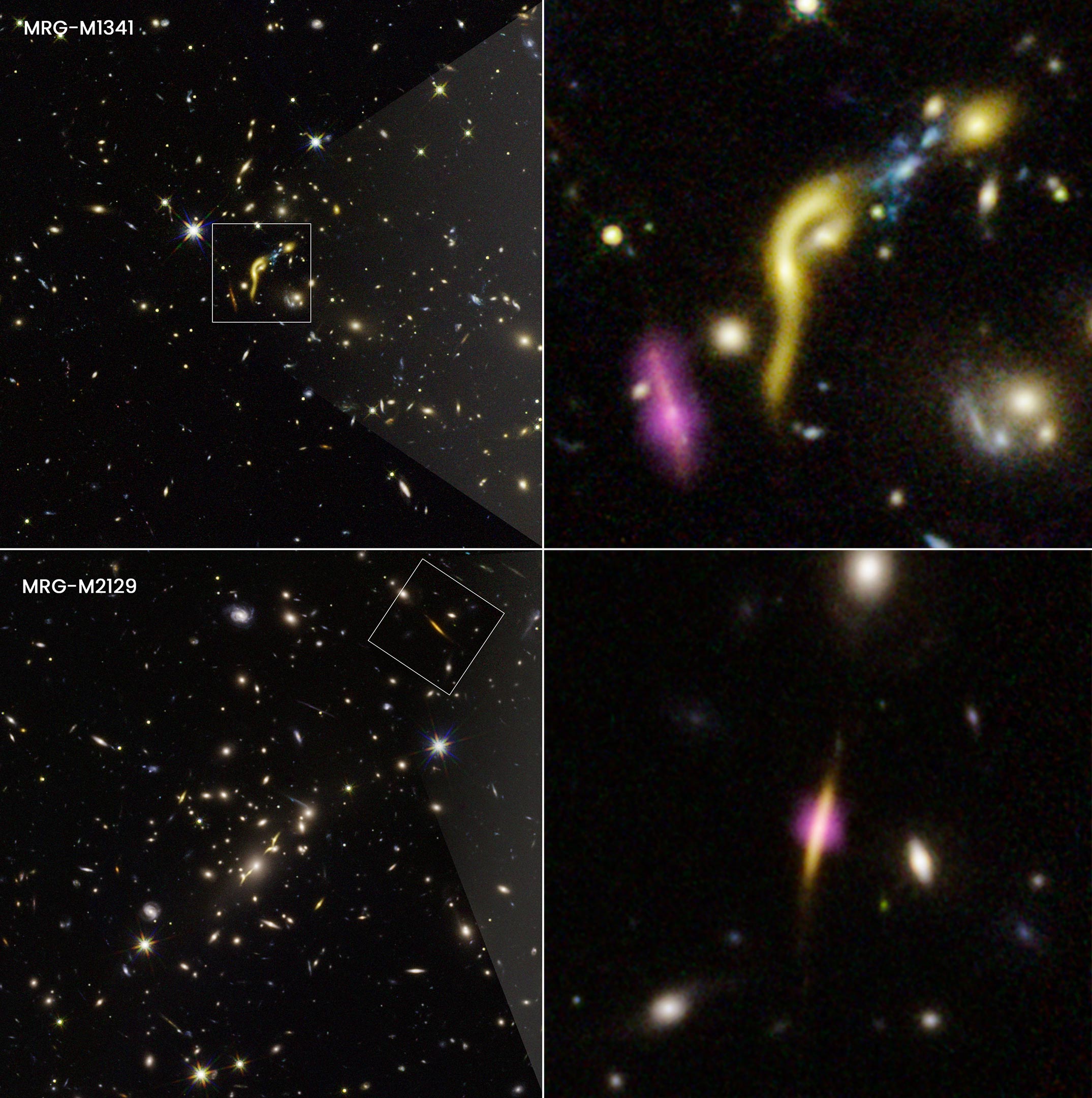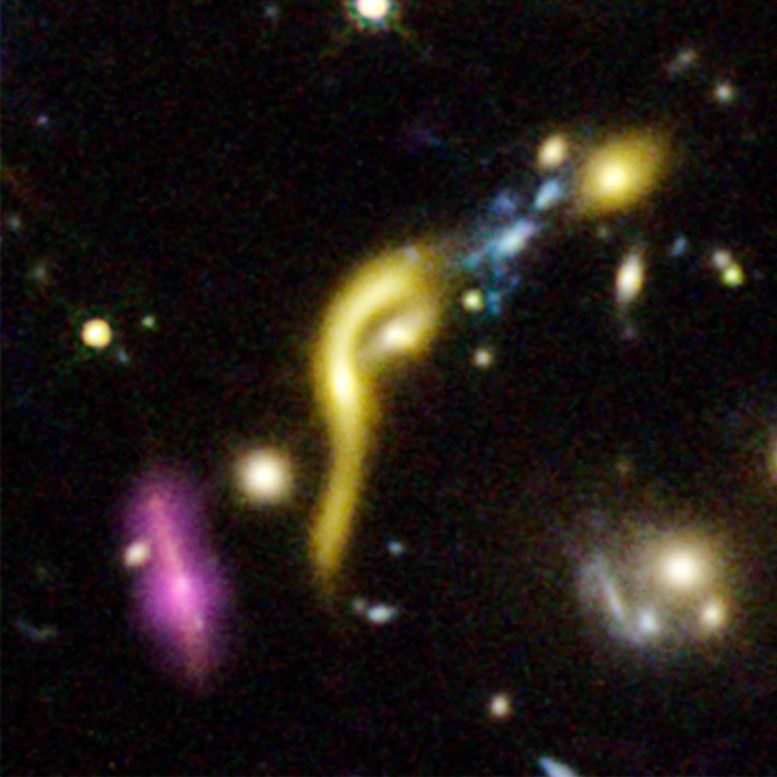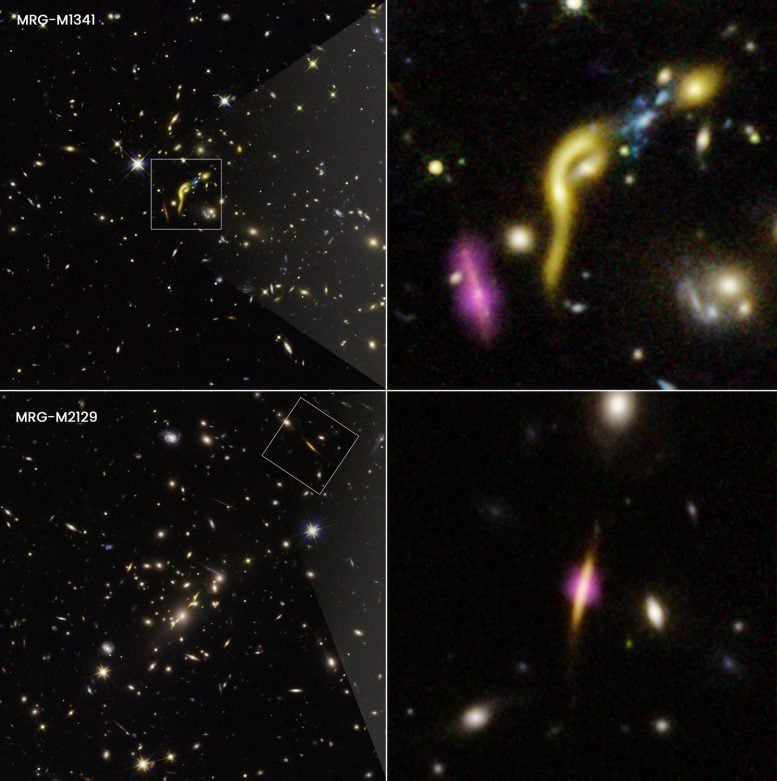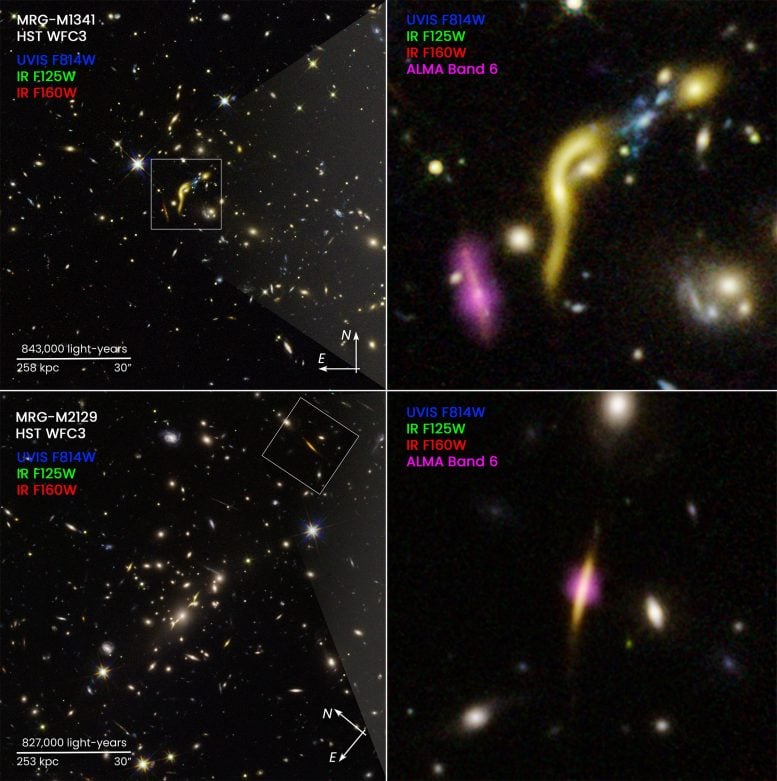
[ad_1]

MACS galaxy cluster J1341. Credit: Principal author: NASA, ESA, Katherine E. Whitaker (UMass), Image processing: Joseph DePasquale (STScI)
Hubble discovers massive and early galaxies running empty
“Live fast, die young” could be the motto of six early, massive and “dead” galaxies that lacked the cold hydrogen gas needed to make stars early in the life of the universe. These galaxies have lived fast and furious lives, creating their stars in a remarkably short time. But then they literally ran out of gas and stopped star formation. Without more fuel to create stars, these galaxies were running empty. Why it happened so early is a mystery.
Nasa‘s The Hubble Space Telescope, with the Atacama Large Millimeter / submillimeter Array (ALMA) in northern Chile, found these strange galaxies looking back billions of years to the peak of star births in the universe. To locate very distant galaxies, scientists combined the power of Hubble and ALMA with extremely massive foreground galaxy clusters acting like natural telescopes. Through a phenomenon called a strong gravitational lens, the immense gravity of a giant galaxy cluster distorts space, bending and magnifying the light of background objects. When an ancient, massive, and far-away galaxy is positioned behind such a cluster, it appears significantly stretched and enlarged, allowing astronomers to study details that would otherwise be impossible to see.

These images are composites of NASA’s Hubble Space Telescope and the Atacama Large Millimeter / submillimeter Array (ALMA). The framed and extracted images show two of six massive and distant galaxies where scientists found star formation had ceased due to the depletion of a fuel source, cold hydrogen gas.
Hubble, along with ALMA, found these strange galaxies when they combined their forces with the “natural lens” in space created by massive clusters of galaxies in the foreground. The gravity of the clusters stretches and amplifies the light of the background galaxies in an effect called the gravitational lens. This phenomenon allows astronomers to use massive galaxy clusters as natural magnifying glasses to study details in distant galaxies that would otherwise be impossible to see.
Yellow traces the glow of starlight. The artificial purple color traces the cold dust of ALMA’s observations. This cold dust is used as a substitute for the cold hydrogen gas required for star formation.
Even with ALMA’s sensitivity, scientists cannot detect dust in most of the six sampled galaxies. An example is MRG-M1341, top right. It appears distorted by the “funhouse mirror” optical effects of the lens. In contrast, the purple spot to the left of the galaxy is an example of a galaxy rich in dust and gas.
An example of cold dust detection performed by ALMA is galaxy MRG-M2129 in the lower right. The galaxy has nothing but dust and gas in the very center. This suggests that star formation may have stopped from the periphery to the interior.
Credit: Principal author: NASA, ESA, Katherine E. Whitaker (UMass), Image processing: Joseph DePasquale (STScI)
When the universe was about 3 billion years old, only 20% of its current age, it experienced the most prolific starbirth period in its history. But when NASA’s Hubble Space Telescope and the Atacama Large Millimeter / submillimeter Array (ALMA) in northern Chile looked towards cosmic objects during this time, they found something strange: six early galaxies. , massive and “dead” that ran out of cold hydrogen. gas needed to make stars.
Without more fuel for star formation, these galaxies were literally running on empty. The results are published in the journal Nature.
“At this point in our universe, all galaxies should form a lot of stars. This is the peak time of star formation, ”said senior author Kate Whitaker, assistant professor of astronomy at the University of Massachusetts, Amherst. Whitaker is also an associate professor at the Cosmic Dawn Center in Copenhagen, Denmark. “So what happened to all the cold gas in these galaxies so soon?” “
This study is a classic example of the harmony between the observations of Hubble and ALMA. Hubble has located where in galaxies stars exist, showing where they formed in the past. By detecting cold dust that serves as a substitute for cold hydrogen gas, ALMA showed astronomers where stars could form in the future if enough fuel was present.

Cluster of galaxies MACS J1341 and MACS J2129. Credit: Principal author: NASA, ESA, Katherine E. Whitaker (UMass), Image processing: Joseph DePasquale (STScI)
Using nature’s telescopes
The study of these distant and early dead galaxies was part of the REQUIEM program, which is called Resolving QUIEscent Magnified Galaxies At High Redshift. (Redshift occurs when light is stretched by expanding space and appears shifted toward the red part of the spectrum. The farther a galaxy is from the observer, the redder it appears.)
The REQUIEM team uses extremely massive foreground galaxy clusters as natural telescopes. The immense gravity of a cluster of galaxies distorts space, bending and magnifying the light of background objects. When an ancient, massive, and far-away galaxy is positioned behind such a cluster, it appears significantly stretched and enlarged, allowing astronomers to study details that would otherwise be impossible to see. This is called a “strong gravitational lens”.
It was only by combining the exquisite resolution of Hubble and ALMA with this powerful lens that the REQUIEM team were able to understand the formation of these six galaxies, which appear as they did just a few billion years ago. after the big bang.
“Using a powerful gravitational lens as a natural telescope, we can find the distant, most massive and first galaxies to stop star formation,” Whitaker said. “I like to think of it as doing science in the 2030s or 1940s – with powerful next-gen space telescopes – but today more of a combination of the capabilities of Hubble and ALMA, which are bolstered by a powerful lens. ”
“REQUIEM has assembled the largest sample to date of these rare, dead strong-lensed galaxies in the early universe, and a strong lens is key here,” said Mohammad Akhshik, principal investigator of the Hubble Observation Program. “It amplifies light at all wavelengths so it’s easier to detect, and you also get higher spatial resolution when you have these galaxies stretched across the sky. You can basically see inside of them at much finer physical scales to understand what’s going on.
Live fast, die young
These kinds of dead galaxies do not seem to be rejuvenating, even through subsequent minor mergers and accretions of small galaxies and nearby gases. Gobbling up things around them only “inflates” galaxies. If the star formation comes back on, Whitaker described it as “some kind of frosting.” About 11 billion years later in the current universe, these once-compact galaxies are believed to have evolved to become larger, but are still dead in terms of new star formation.
These six galaxies have lived fast and furious lives, creating their stars in a remarkably short time. Why they stopped star formation so early is still a puzzle.
Whitaker offers several possible explanations: “Did a supermassive black hole in the center of the galaxy, turn on and heat all the gas? If so, the gas could still be there, but now it’s hot. Or it could have been kicked out and now it is prevented from building up in the galaxy. Or has the galaxy used it all and the supply is cut off? These are some of the open questions that we will continue to explore with new observations down the road. “
Reference: “Depleted Gas Reservoirs Lead to Mass Extinction of Galaxies in Early Universe” by Katherine E. Whitaker, Christina C. Williams, Lamiya Mowla, Justin S. Spilker, Sune Toft, Desika Narayanan, Alexandra Pope, Georgios E. Magdis, Pieter G. van Dokkum, Mohammad Akhshik, Rachel Bezanson, Gabriel B. Brammer, Joel Leja, Allison Man, Erica J. Nelson, Johan Richard, Camilla Pacifici, Keren Sharon & Francesco Valentino, September 22, 2021, Nature.
DOI: 10.1038 / s41586-021-03806-7
The Hubble Space Telescope is an international cooperation project between NASA and ESA (European Space Agency). NASA’s Goddard Space Flight Center in Greenbelt, Maryland manages the telescope. The Space Telescope Science Institute (STScI) in Baltimore, Maryland, conducts Hubble science operations. STScI is operated for NASA by the Association of Universities for Research in Astronomy, in Washington, DC
[ad_2]
Source link